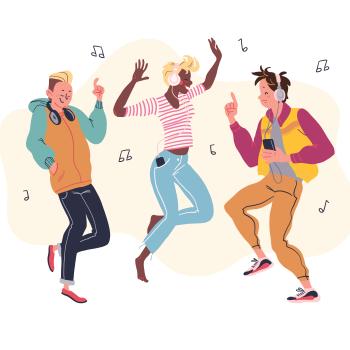Playlist for Holden: Character Analysis With Music and Lyrics

- Preview |
- Standards |
- Resources & Preparation |
- Instructional Plan |
- Related Resources |
- Comments
Overview
Compiling a playlist for a friend or a special occasion is a familiar activity for most students. This minilesson invites students to think of a literary character as a peer, creating an authentic connection between literature and life. While the lesson uses The Catcher in the Rye as an example, the activities could be centered on the primary character of any novel. Students choose a perspective on the character (from options suggested by the teacher) and work in small groups to identify scenes in the novel that reflect their view. They then select songs appropriate for the character and write a rationale for each song chosen, including supporting evidence from the text. When students present their completed playlists in class, their classmates inevitably make observations that increase everyone's insights into the character and the novel.
Featured Resources
- Playlist for Holden Assignment: This handout outlines the assignment: selecting a playlist, writing a personal letter, and writing a one-paragraph rationale for each song included on the playlist
From Theory to Practice
- Asking students to critically analyze popular music in light of character and themes from a novel requires sophisticated skills, including the ability to understand literary figures in the context of contemporary life.
- Viewing literature through contemporary culture and current events can help reframe the literary experience for students.
- Probing the identity of a literary character in terms of popular songs and popular culture may help students understand their own motivation and identity.
- Music and identity are closely intertwined among many adolescents.
Common Core Standards
This resource has been aligned to the Common Core State Standards for states in which they have been adopted. If a state does not appear in the drop-down, CCSS alignments are forthcoming.
State Standards
This lesson has been aligned to standards in the following states. If a state does not appear in the drop-down, standard alignments are not currently available for that state.
NCTE/IRA National Standards for the English Language Arts
- 1. Students read a wide range of print and nonprint texts to build an understanding of texts, of themselves, and of the cultures of the United States and the world; to acquire new information; to respond to the needs and demands of society and the workplace; and for personal fulfillment. Among these texts are fiction and nonfiction, classic and contemporary works.
- 2. Students read a wide range of literature from many periods in many genres to build an understanding of the many dimensions (e.g., philosophical, ethical, aesthetic) of human experience.
- 3. Students apply a wide range of strategies to comprehend, interpret, evaluate, and appreciate texts. They draw on their prior experience, their interactions with other readers and writers, their knowledge of word meaning and of other texts, their word identification strategies, and their understanding of textual features (e.g., sound-letter correspondence, sentence structure, context, graphics).
- 5. Students employ a wide range of strategies as they write and use different writing process elements appropriately to communicate with different audiences for a variety of purposes.
Materials and Technology
- Computers with Internet access and media player application installed (optional)
- iPods or other media players (optional)
- List of suggested popular songs with lyrics (optional)
Printouts
Websites
Note: The LitTunes website links classical literature and poetry with popular songs. It is listed here as a source of ideas and inspiration for teachers, rather than as a resource for students. Although the site makes some very nice correlations, “classic rock” is overrepresented in comparison with other musical genres. Also, be forewarned that many of the links to YouTube videos may be dead.
Preparation
- Choose a fictional character familiar to students to be the focus of the lesson. The lesson will be most effective if the students are studying a novel that is focused on a single primary character. The example used here is Holden Caulfield from J.D. Salinger’s novel Catcher in the Rye, a universally recognized iconic character, but the lesson activities would be equally effective with a major character from any novel.
- If students will be choosing their playlists in class, make sure they can access the suggested websites on their computers. Note that for access to iTunes, each computer must have the iTunes software installed.
- Make a copy for each student of the Playlist for Holden Assignment.
- Decide whether you are going to devote time to the playlist in class or have students complete it as homework. Schedule access to school computers and/or set due dates for assignments accordingly.
- Write the following statements on the board (or, if you are adapting the lesson for another literary character, provide similar contrasting statements to describe that character):
- Statement 1: Holden Caulfield is an insightful, wise adolescent who points out and analyzes many of the flaws of our society.
- Statement 2: Holden Caulfield is more hypocritical than insightful. He says one thing and then does another, and he relies upon cynicism and sarcasm in addressing the flaws of society.
- Statement 1: Holden Caulfield is an insightful, wise adolescent who points out and analyzes many of the flaws of our society.
Student Objectives
Students will
- Analyze a fictional character (through dialogue, plot, conflict, and resolution)
- Evaluate lyrics and music of popular songs for appropriate thematic connections with the character
- Apply evidence from the text to support their selections
Session 1
- Ask students to think about each statement on the board and to decide which they feel is the more accurate assessment of Holden Caulfield (see Preparation, Step 5). Have them write a short list of reasons for their choice.
- Under their list of reasons for choosing Statement 1 or Statement 2, ask students to compile a list of two or three scenes from the book that support their choice, making note of the page number for each scene.
- After students have worked individually to write rationales and identify scenes from the book (with their corresponding page numbers), ask them to announce their perspective (siding with either Statement 1 or Statement 2) and form a group with two to three other students (four students maximum per group) who share the same view.
- Have each group select a group leader and then have students share their rationales with their group. The group leader compiles the lists of reasons and scenes into a single list, ferreting out weak choices and adding any new ones suggested during the discussion.
- When all groups are ready, each group’s list is presented to the class by the group leader. Encourage students to comment upon the relative merits of the evidence provided.
Note: This is a good introduction to the project, as it allows students a chance to develop individual opinions of Holden, as well as to think of the moments within the novel that may have shaped those opinions. Once students have discussed their thoughts about Holden in their groups and you are comfortable with their understanding of the character, move on to the larger project. - Have students move back to their original seats. Distribute the Playlist for Holden Assignment handout and go over the instructions.
- Discuss the handout step by step to clarify expectations.
- Have students begin brainstorming for songs they may wish to use; ask students to write down lists of songs and some possible related scenes.
Session 2
Note: Session 2 may follow directly after Session 1.
- Have students return to their groups from Session 1. Students will work together to create the rationale, the letter, and the playlist, with one student acting as the leader for each assignment. The group leader begins by describing the overall process and explaining possible difficulties or differences of opinion within the group. The group leader then compiles a playlist agreed upon by group members and ensures that the correlations for each song are well-substantiated through textual evidence.
- A second member of the group leads the letter writing, and a third member of the group crafts the rationale. (The fourth member of the group, if there is one, helps with the rationale or the letter.)
- When all groups have finished their playlists, rationales, and letters, have each group present their work to the rest of the class. The student in charge of the rationale presents Holden’s playlist, along with evidence from the book for each song selected. The student in charge of writing the letter reads it to class.
- After each presentation, invite students from other groups to evaluate the strengths and weaknesses of songs on the playlist, citing compatible or contrary evidence from the book. Also invite students to comment upon the suitability of the letter to Holden.
Extensions
Students who are more visual may prefer to tell Holden’s story in graphic novel format. See Holden Caulfield—The Graphic Novel handout for a description of this project. Assessment for Holden Caulfield—The Graphic Novel can be used to evaluate this project.
Student Assessment / Reflections
Use the rubrics Assessment for Playlist for Holden: The Songs and Assessment for Playlist for Holden: The Letter to evaluate the projects. You can either evaluate the projects as a whole, with each member of the group receiving the same grade, or, if you prefer, assign individual grades based upon the primary responsibilities of each student during the project.

Thanks
Thanks
Thanks
Add new comment